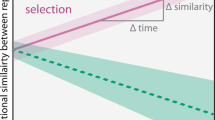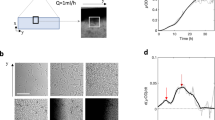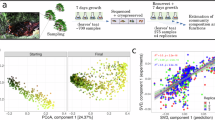Abstract
The order and timing of species arrival during community assembly can have long term effects on community structure due to priority effects. The importance of such processes in complex bacterial communities where dispersal involves mixing of entire communities is currently not known. Here we used a transplant experiment with two bacterioplankton communities of different origin (freshwater and brackish). Sterile medium of each origin was initially inoculated with a bacterial community of different (‘alien’) origin, followed by dispersal of the respective ‘home’ community at different time points after initial inoculation. We found that the later the dispersal with the ‘home’ community occurred the smaller the effect on the final community composition. This suggests that priority effects by the initially inoculated community reduce the establishment success of taxa from the later arriving community and that this effect depends on dispersal timing.
Similar content being viewed by others
Log in or create a free account to read this content
Gain free access to this article, as well as selected content from this journal and more on nature.com
or
References
Altermatt F, Bieger A, Carrara F, Rinaldo A, Holyoak M . (2011). Effects of connectivity and recurrent local disturbances on community structure and population density in experimental metacommunities. PLoS One 6: e19525.
Andersson MGI, Berga M, Lindström ES, Langenheder S . (2014). The spatial structure of bacterial communities is influenced by historical environmental conditions. Ecology 95: 1134–1140.
De Meester L, Vanoverbeke J, Kilsdonk LJ, Urban MC . (2016). Evolving perspectives on monopolization and priority effects. Trends Ecol Evol 31: 136–146.
Dickie IA, Fukami T, Wilkie JP, Allen RB, Buchanan PK . (2012). Do assembly history effects attenuate from species to ecosystem properties? A field test with wood‐inhabiting fungi. Ecol Lett 15: 133–141.
Evans S, Martiny JBH, Allison SD . (2016). Effects of dispersal and selection on stochastic assembly in microbial communities. ISME J 11: 176–185.
Fukami T, Beaumont HJE, Zhang XX, Rainey PB . (2007). Immigration history controls diversification in experimental adaptive radiation. Nature 446: 436–439.
Fukami T, Dickie IA, Paula Wilkie J, Paulus BC, Park D, Roberts A et al. (2010). Assembly history dictates ecosystem functioning: evidence from wood decomposer communities. Ecol Lett 13: 675–684.
Fukami T . (2015). Historical contingency in community assembly: integrating niches, species pools, and priority effects. Annu Rev Ecol Evol Syst 46: 1–23.
Hewitt CL, Huxel GR . (2002). Invasion success and community resistance in single and multiple species invasion models: do the models support the conclusions? Biol Invasions 4: 263–271.
Hiscox J, Savoury M, Müller CT, Lindahl BD, Rogers HJ, Boddy L . (2015). Priority effects during fungal community establishment in beech wood. ISME J 9: 2246–2260.
Jiang L, Patel SN . (2008). Community assembly in the presence of disturbance: a microcosm experiment. Ecology 89: 1931–1940.
Langenheder S, Kisand V, Wikner J, Tranvik LJ . (2003). Salinity as a structuring factor for the composition and performance of bacterioplankton degrading riverine DOC. FEMS Microbiol Ecol 45: 189–202.
Lindström ES, Östman Ö . (2011). The importance of dispersal for bacterial community composition and functioning. PLoS One 6: e25883.
Pu Z, Jiang L . (2015). Dispersal among local communities does not reduce historical contingencies during metacommunity assembly. Oikos 124: 1327–1336.
Rainey PB, Travisano M . (1998). Adaptive radiation in a heterogeneous environment. Nature 394: 69–72.
Rillig MC, Antonovics J, Caruso T, Lehmann A, Powell JR, Veresoglou SD et al. (2015). Interchange of entire communities: microbial community coalescence. Trends Ecol Evol 30: 470–476.
Shulman MJ, Ogden JC, Ebersole JP, McFarland WN, Miller SL, Wolf NG . (1983). Priority effects in the recruitment of juvenile coral-reef fishes. Ecology 64: 1508–1513.
Souffreau C, Pecceu B, Denis C, Rummens K, De Meester L . (2014). An experimental analysis of species sorting and mass effects in freshwater bacterioplankton. Freshwater Biol 59: 2081–2095.
Vass M, Langenheder S . (2017). The legacy of the past: effects of historical processes on microbial metacommunities. Aquat Microb Ecol 79: 13–19.
Zha Y, Berga M, Comte J, Langenheder S . (2016). Effects of dispersal and initial diversity on the composition and functional performance of bacterial communities. PloS One 11: e0155239.
Acknowledgements
We thank the anonymous reviewers for their comments that led us to the improvement of the manuscript.
Author information
Authors and Affiliations
Ethics declarations
Competing interests
The authors declare no conflict of interest.
Additional information
Supplementary Information accompanies this paper on The ISME Journal website
Supplementary information
Rights and permissions
About this article
Cite this article
Svoboda, P., Lindström, E., Ahmed Osman, O. et al. Dispersal timing determines the importance of priority effects in bacterial communities. ISME J 12, 644–646 (2018). https://doi.org/10.1038/ismej.2017.180
Received:
Revised:
Accepted:
Published:
Issue date:
DOI: https://doi.org/10.1038/ismej.2017.180
This article is cited by
-
Routes and rates of bacterial dispersal impact surface soil microbiome composition and functioning
The ISME Journal (2022)
-
Farm-scale differentiation of active microbial colonizers
ISME Communications (2022)
-
Priority effects in microbiome assembly
Nature Reviews Microbiology (2022)
-
Repeated introduction of micropollutants enhances microbial succession despite stable degradation patterns
ISME Communications (2022)
-
Meter-scale variation within a single transect demands attention to taxon accumulation curves in riverine microbiome studies
Frontiers of Environmental Science & Engineering (2022)



